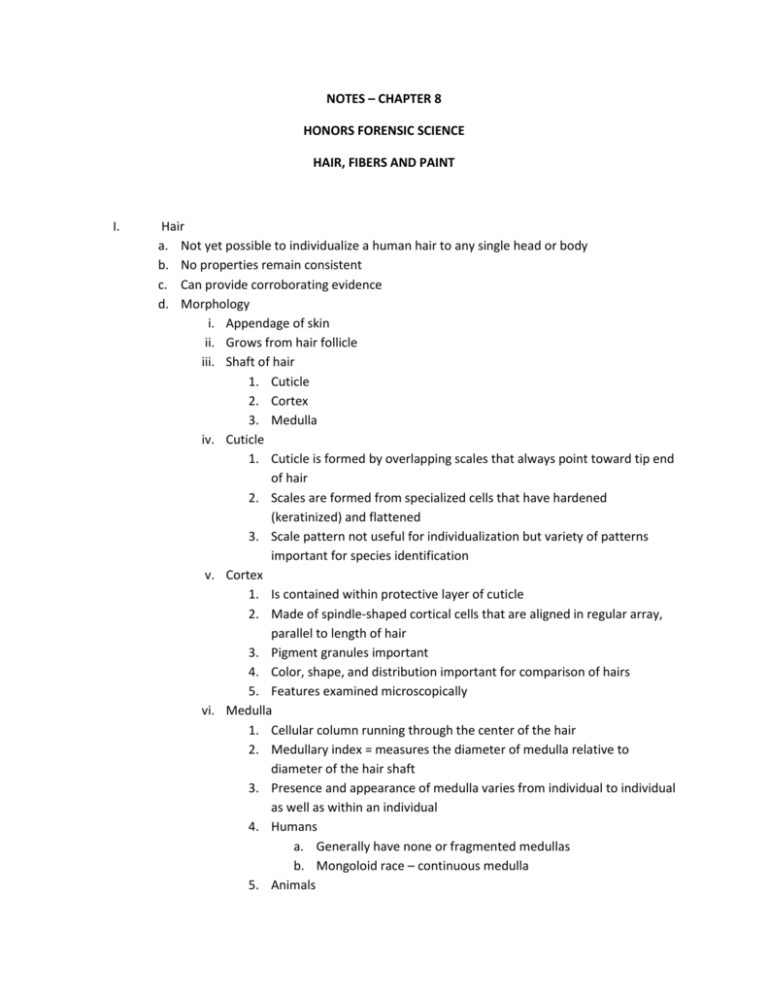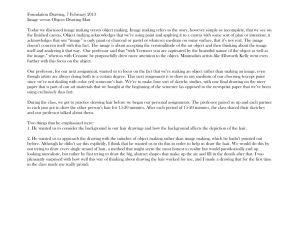NOTES – CHAPTER 8 HONORS FORENSIC SCIENCE HAIR
advertisement

NOTES – CHAPTER 8 HONORS FORENSIC SCIENCE HAIR, FIBERS AND PAINT I. Hair a. Not yet possible to individualize a human hair to any single head or body b. No properties remain consistent c. Can provide corroborating evidence d. Morphology i. Appendage of skin ii. Grows from hair follicle iii. Shaft of hair 1. Cuticle 2. Cortex 3. Medulla iv. Cuticle 1. Cuticle is formed by overlapping scales that always point toward tip end of hair 2. Scales are formed from specialized cells that have hardened (keratinized) and flattened 3. Scale pattern not useful for individualization but variety of patterns important for species identification v. Cortex 1. Is contained within protective layer of cuticle 2. Made of spindle-shaped cortical cells that are aligned in regular array, parallel to length of hair 3. Pigment granules important 4. Color, shape, and distribution important for comparison of hairs 5. Features examined microscopically vi. Medulla 1. Cellular column running through the center of the hair 2. Medullary index = measures the diameter of medulla relative to diameter of the hair shaft 3. Presence and appearance of medulla varies from individual to individual as well as within an individual 4. Humans a. Generally have none or fragmented medullas b. Mongoloid race – continuous medulla 5. Animals II. a. Most have continuous or interrupted medullas 6. Shape – a. Humans – nearly cylindrical in appearance b. Animals – patterned shape c. Databases are available vii. Root 1. Three phases of hair growth a. Anagen – initial growth phase during which the hair follicle is actively producing hair b. Catagen – transition stage between anagen and telogen phases c. Telogen – final growth phase in which hair naturally falls out of the skin 2. Shape of root depends on phase of hair growth a. Anagen – follicular tag b. Catagen – elongated appearance c. Telogen – club-shaped appearance Identification and Comparison of Hair a. Generally when dealing with hair evidence, you are either: i. Trying to determine if human or animal ii. Species ID of animal iii. If human, does it match hair from a suspect? b. In comparing hair, criminalist is interested in i. Color ii. Length iii. Diameter iv. Presence or absence of medulla v. Distribution, shape and color of pigment granules in cortex c. Mainly, hair is class evidence d. Can use probabilities to tell if 2 hairs came from same individual e. Can be very useful f. Can the Body area of a hair be determined? i. Yes usually without difficulty ii. Scalp hair – little diameter variation, uniform distribution of pigment granules iii. Pubic hair – short, curly, wide variations in shaft diameter, continuous medulla iv. Beard hair – coarse, normally triangular in cross-section, blunt tips g. Can racial origin of hair be determined? i. Sometimes ii. Caucasian – usually straight or wavy, pigments more evenly distributed, oval in cross-section iii. Negroid – curly, dense and unevenly distributed pigments, oval to flat in shape iv. Extreme variation however, so care must be taken h. Can the age and sex of a person’s hair be determined? III. IV. i. Only infant hair can be identified 1. Fine, short in length, fine pigment, rudimentary in character ii. No technique to accurately determine sex i. Is it possible to determine if hair was forcible removed? i. Root hair with follicular tissue adhering to it = hair was forcibly removed ii. Bulbous shaped root, free of any tissue = hair naturally fell out j. Are efforts being made to individualize human hair? i. Can link human hair to a particular individual by characterizing the nuclear DNA present in hair root or in follicular tissue adhering to root ii. Can also extract some DNA from hair when in anagen or catagen phase of growth iii. Nuclear DNA – DNA present within the nucleus of a cell 1. Inherited from both parents iv. Mitochondrial DNA – DNA present in mitochondria located outside cell nucleus 1. Mitochondria supply energy to cell 2. DNA here is inherited from mother only Collection of hair evidence a. Questioned hairs must be submitted with adequate numbers of control hairs from victims and suspects b. Hairs must be collected and submitted from various parts of body (head, pubis, chest, etc.) Fibers a. Natural i. Derived entirely from animal or plant sources ii. Wool, mohair, cashmere, fur, cotton b. Man-made i. Derived from either natural or synthetic polymers ii. Polyesters, nylons, rayons, etc. iii. Regenerated 1. Usually raw material of cotton or wood pulp 2. Cellulose extracted, treated, and forced through small holes of spinneret 3. Rayon, acetate, triacetate iv. Synthetic 1. Produced solely from synthetic chemicals 2. Nylons, polyesters, acrylics 3. Became reality when scientists developed method of synthesizing polymers a. Polymer = a substance composed of a large number of atoms; atoms are usually arranged in repeating units called monomers b. Polymer is basic chemical substance of all synthetic fibers c. Often called macromolecules V. d. Can change basic structure of molecules and how they are linked together to change properties of polymer c. Identification and Comparison of Fibers i. Man-made fibers 1. Evidential value is related to ability to trace origin 2. Most often is comparative in nature 3. Compare color and diameter 4. Also compare lengthwise striations on surface, pitting of surface, shape 5. Need to compare dye composition also 6. Use chromatography to separate dye consitutuents 7. Chemical comparison 8. Often have crystalline properties so can measure birefringence 9. Light passing through fiber is polarized so will have characteristic index of refraction 10. Infrared spectrophotometry to identify class or sub-class of fiber 11. In the end, it is still class evidence d. Collection of Fiber Evidence i. Can be easily overlooked ii. Have to identify and collect possible carriers of fiber evidence iii. Care taken to avoid loss of evidence or contamination Paint a. Commonly encountered form of evidence b. Found often in hit-and-run and burglary cases c. Compare paint chips to determine common origin d. Also can assist in identifying color, make and model of automobiles e. What is Paint? i. Paint = pigments, additives and binder all dissolved or dispersed in a suitable solvent ii. Pigments 1. Impart color and opacity 2. Usually mixtures of different organic and inorganic compounds iii. Binder 1. Provides support medium for pigments and additives 2. Polymeric substance f. Automotive Finishing System i. Electrocoat Primer 1. Provides corrosion resistance 2. Color ranges from gray to black ii. Primer Surface 1. Corrosion control and smooth out finish 2. Epoxy-modified polyesters 3. Highly pigmented; match with topcoat iii. Basecoat 1. Provides color and aesthetics to finish 2. Binder system = acrylic – based polymer 3. Different pigments added iv. Clearcoat 1. Unpigmented 2. Improve gloss, durability, and appearance 3. Acrylic based or polyurethane g. Comparing Paint i. Once comparison is complete: 1. Task of assessing the significance of the findings begins 2. Often can identify make and model of car or make strong link between suspect car and crime scene, other times it is not as clear cut h. Collection and Preservation of Paint Evidence i. Paint chips picked up with tweezers or scooped up with paper ii. Utmost care needed iii. Control paints need to be collected iv. If paint is smeared or embedded, do not remove it.








